This is the third of a four-part preview on what to look at teams in the remaining fixtures from a tactical perspective. The Premier League is returning on 17 June! We have missed English football for quite a while since the COVID-19, most teams would have a full squad because of this long break.
This tactical analysis is mainly giving a brief analysis of the team style of plays. By looking at their strengths and weaknesses, we provide you with some hints on what to focus on in the remaining fixtures.
In the third analysis, we investigate the tactics of Manchester United, Wolves, Sheffield United, Southampton and Watford.
Manchester United
Expected points: 48.2 – (4th)
Points: 45 – (5th)
United were having a fluctuating season under Ole Gunnar Solskjær, but winning three Manchester Derby out of four was really some exciting results. They were a bit unstable this season, losing points to bottom half teams such as Bournemouth, Brighton and Newcastle. However, a big signing in winter upgraded the team a lot – you know who I am talking about: Bruno Fernandes.
With Fernandes joining the team, United often deployed a 4-3-1-2 or a 3-4-1-2 formation. The 1-2 triangular shape upfront was the key, as Fernandes always played as an attacking midfielder behind two strikers.
As a result, this generated more variations when the front three swapped their positions. Anthony Martial, who was also available to play as a winger, tended appeared at flanks to take the ball. This undoubtedly stretched the defence as the United formation lacked wingers. You could see the Everton backline is being stretched as Séamus Coleman approached the Frenchman.
In these cases, Fernandes was clever to exploit the horizontal gaps between defenders by his forward runs. If Fernandes was receiving the ball out wide, he instructed the wide defender to make an underlapping or an overlapping run. Since Daniel James, Martial and Marcus Rashford all possesses pace, they were likely to receive the through balls when running behind the defence.
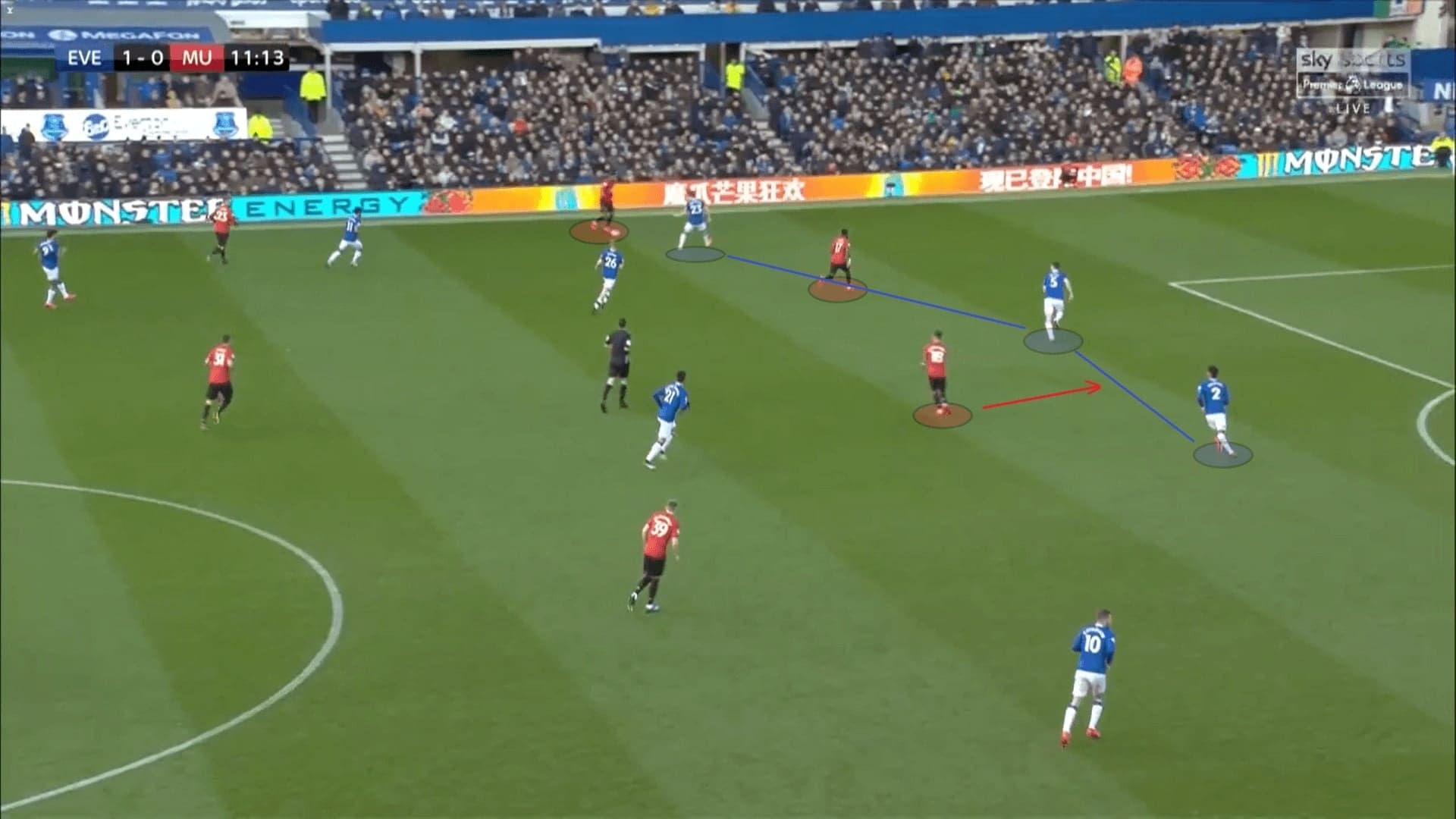
United scored seven long shots this season, a lot higher than the league average of 4.6. Huge credits should be given to Mason Greenwood, who outperformed his 4.03 xG by scoring five goals. We would expect the 18-year-old to be a potentially super-sub in the remaining games.
Despite purchasing an expensive ball playing central-defender: Harry Maguire, United were not playing out from the back. Instead, they were strong in the offensive transitions as the front players were pacey. The Red Devils had eight goals from the counter-attacks – only lower than Leicester City’s 10.
A recurring pattern would be: Fred regained possession, then looks for a progressive option. The Brazilian was doing quite fine in terms of duels and interceptions,
Meanwhile, front players such as Martial, James and Rashford instantly looked to exploit spaces behind the defence or at the wide areas. In this image, you could see James already half-turned his body to get in front of Nicolás Otmendi.
We expect Fernandes would improve the counter-attacks as the Portuguese international has good awareness to scan his surroundings. He often made himself available between the lines and would be a good progressive option for Fred, as he did in the below image.

United conceded 30 goals out of 31.49 xGA after 29 games, which both ranked fourth the league. When playing against City, Liverpool or Chelsea, they had to defend more by a low block, it was tough to beat when considering United were yet to concede a goal in the positional plays in the above fixtures.
However, we should note that their average PPDA is 9.75, the sixth of the league. United were not a conservative team, they also pressed high and opted a man-orientated scheme, even at the expense of compactness.
As an example, you could see the man-orientated press in the Wolves game – a 4 v4 in Wolves’ half. Although the United players were far from each other, they forced long balls by maintaining a certain level of pressure to the attacking team.
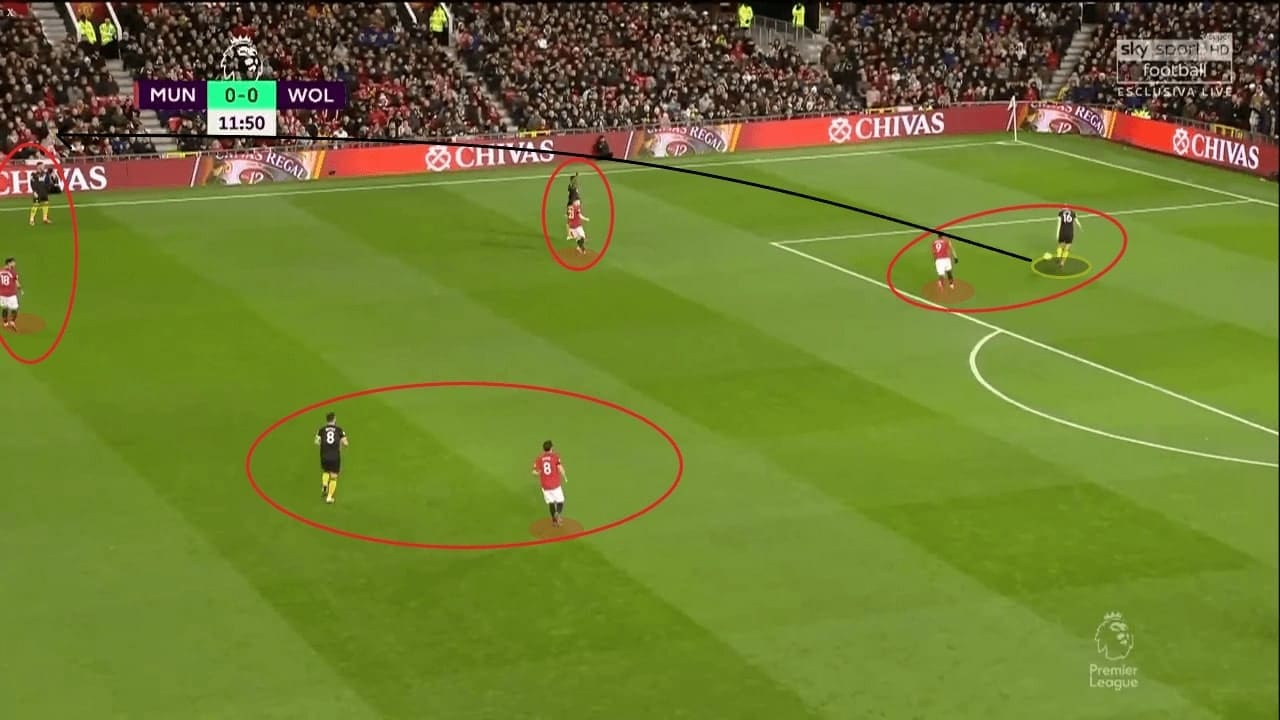
We would question the set-piece performance of United defensively, as they already conceded nine after a set-piece in this season, only two teams were worse. In the last few months, they had some corners because of the general setup and individual issue, we will explain below.
The scheme of United was partially zonal and partially man-marking, what cost them the goals was the former part – where Victor Lindelöf and Maguire were tasked to defend zonally in the six-yard box. However, the two centre-backs seldom stayed closely and left a gap, which was always targeted by the runners.
Usually, we expect Maguire, who was tall (194cm according to the Transfermarkt) to defend this zone, covering that gap with Lindelöf. However, it seems he failed to make his physical quality counted as a result of no sprinting for power generation. This was often the problem.
The man-marking usually take place around the penalty spot, carried out by shorter player – mostly Fred, who was 169cm. The midfielder was not strong in these physical battles, would be hindered by blocking and unable to block the target.
In this case, Brighton were clever to use a decoy run to further drag Lindelöf out of position. As we have drawn, the gap between the centre-backs was enormous. Since Fred was not able to block the run, and Maguire remained static, Brighton scored by exploiting this gap.
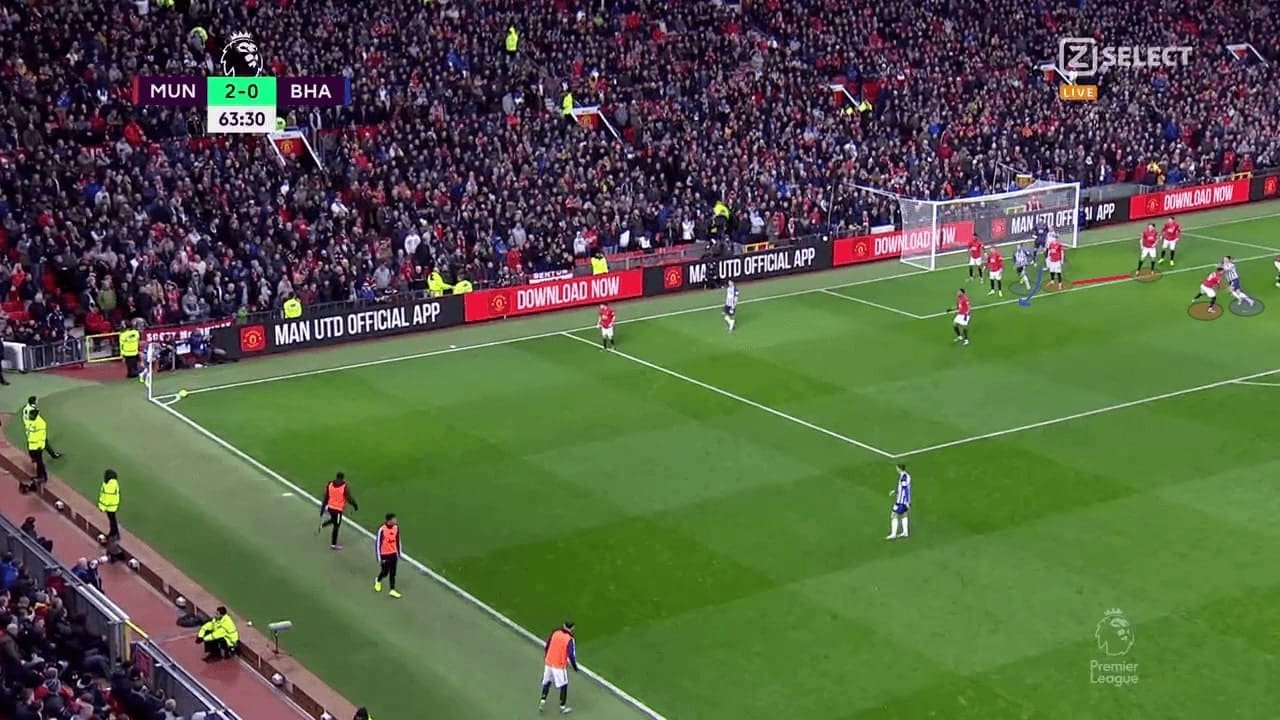
A slight advantage of United was their schedule – they already played most strong teams before the break. We believe Solskjær’s team would continue to dominate the ball on most occasions. Therefore, it would be intriguing to see whether they would develop the positional plays given strong reinforcement such as Fernandes was available.
Remaining opponents: Tottenham (A), Sheffield (H), Brighton (A), Bournemouth (H), Aston Villa (A), Southampton (H), Crystal Palace (A), West Ham (H), Leicester (A)
What to watch: Fernandes, development of positional plays, variations of the man-marking system
Wolves
Expected points: 46.8 – (6th)
Points: 43 – (6th)
Wolves were having another exceptional season after their success in the last campaign. Under Nuno Espírito Santo, the team were demonstrating consistent and stable performance, their 33.6 xGA ranked the fifth of the league. In this season, Nuno only sticks to a back three, shifting between a 3-4-3 or a 3-5-2 because of the injuries.
Since Nuno was not looking for a possession-based playing style, his team did not have to play out from the back although they had quality midfielders such as João Moutinho and Rúben Neves.
In general, we would see the wing-backs pushing high and wide centre-backs split, this opened the shape to stretch the defence. As the central defender of the back three, Conor Coady was tasked to play the out-ball under pressure. Usually, the receiver would be either Matty Doherty or Adama Traoré on the right flank as Coady was natural to shift the ball to this side. What Neves and Moutinho often offered was the wall-pass instead of progressive passes.
In the below image, Tottenham were pressing with five players, man-marking the Wolves players. Trying to play out from the back would be risky as the midfielders were tightly marked. However, Wolves were used to these situations and Coady played the diagonal pass to find the free player at flank – which was his trademark pass.
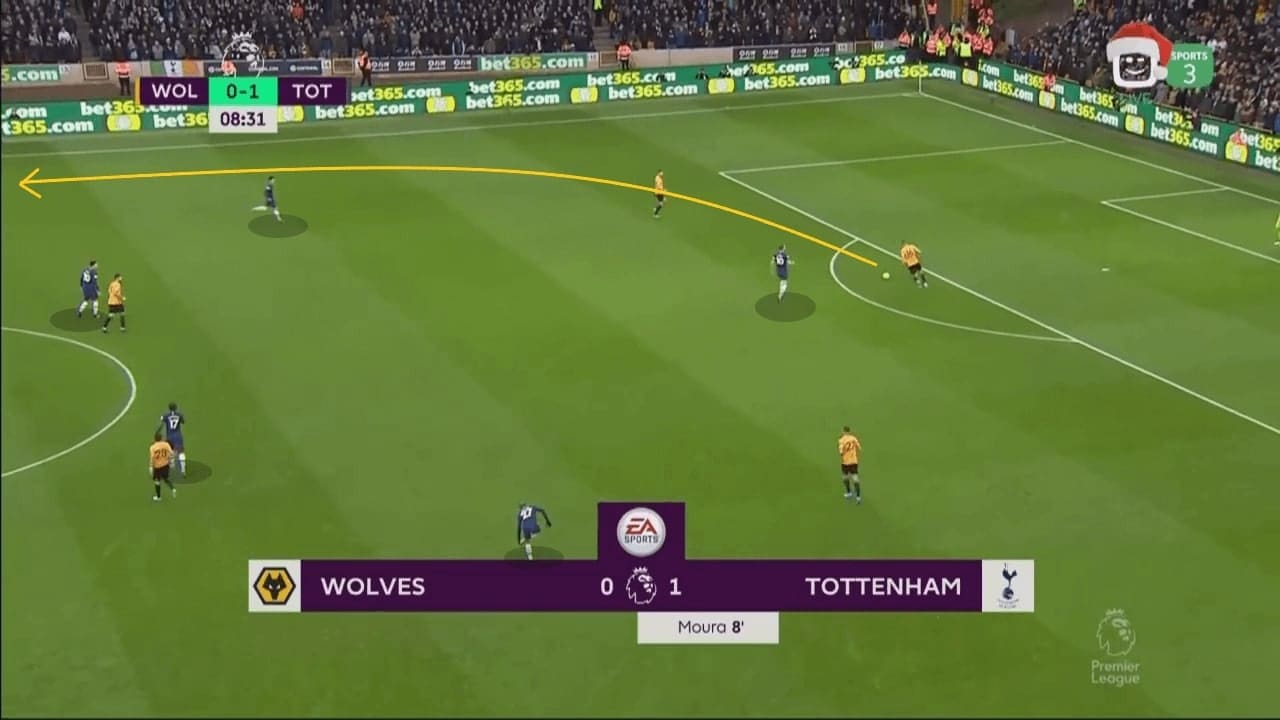
In fact, what makes Wolves very dangerous was their counter-attacks. They scored six in the offensive transitions, more than the league average of 4.4. Traoré shined this season and helped Wolves a lot. Tottenham manager: José Mourinho once described Traoré and Diogo Jota were as quick as a train, which hinted how difficult to deal with these two players.
Traoré was excellent to take on multiple defenders and absorb pressure. Another main man of the attack: Raúl Jiménez was good at moving into goal-scoring positions and convert the opportunities, who recorded over 15 xG in his two Premier League campaigns.
In this example, you could see Traoré was dealing with two players, but he still managed to play the ball Jiménez despite the tremendous pressure. Jiménez then quickly released the wide player – Doherty, who always providing the width when Traoré was doing all the hard work at the half-spaces. This eventually has resulted in a goal.
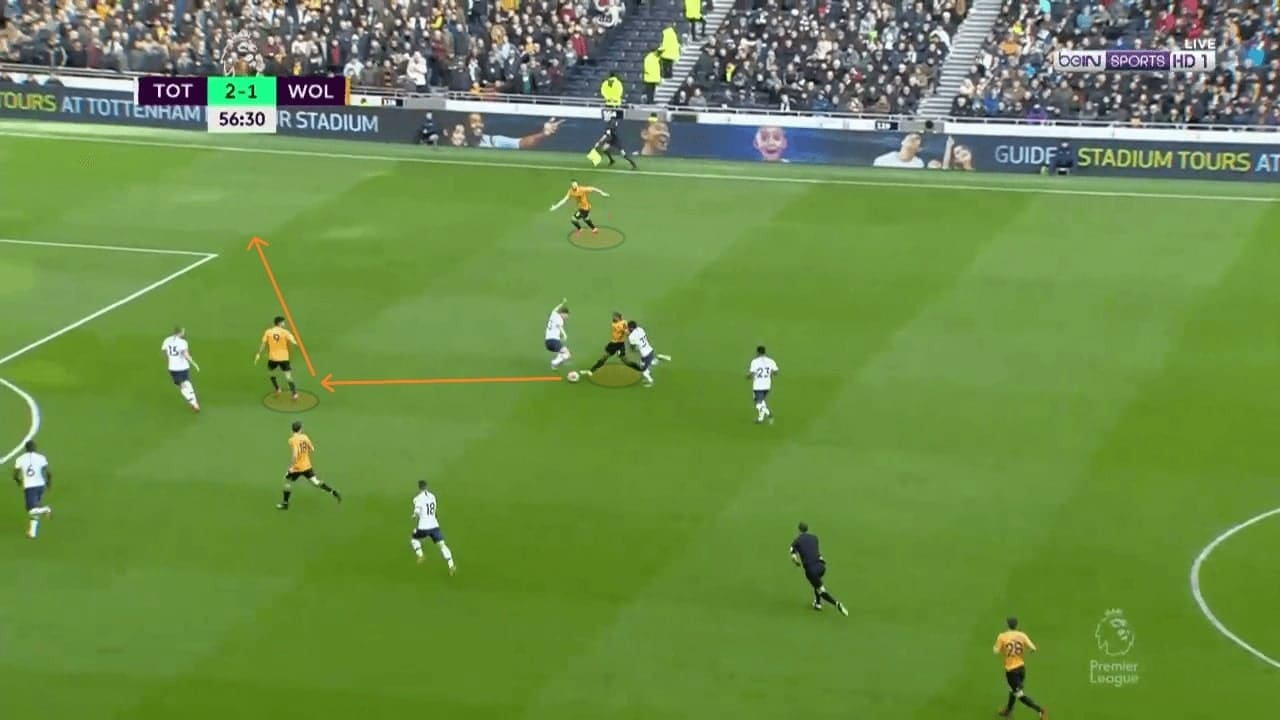
Wolves had one of the highest PPDA in the league, which was 12.40 per game after 29 matches. This has already hinted their defensive style of play – not relying on pressing. Instead, defending with a midblock was commonly seen in Wolves matches.
Basically, we could split the defence of Wolves into two segments: the back five and the front five, or a 5-5 shape if we are using numbers to illustrate. The wingers were disciplined to drop at the midfield, staying extremely compact with the central groups. This aimed to cover the half-spaces, and you could see the proximity of the front five in this image.
In most cases, a clear objective of such setups would be guiding the ball to the wide area. Since five Wolves players were defending at the centre initially, hardly could the attacking team overload this area and the easiest option was to play the ball wide. This was the direction of Çağlar Söyüncü’s pass in this image.
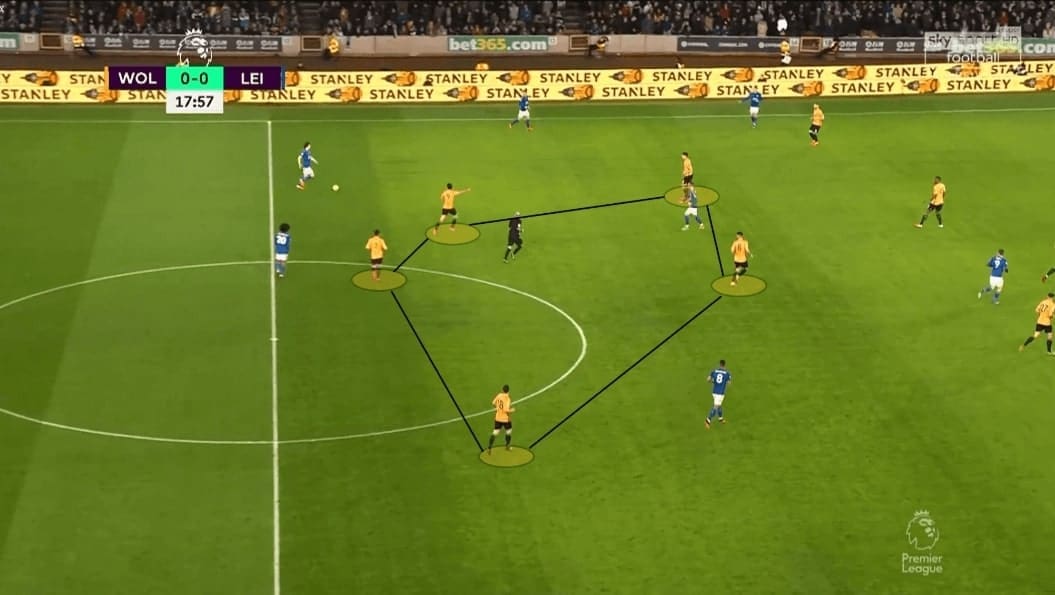
In the wide areas, Wolves were enjoying a numerical advantage to win the ball back. At least, they had a winger, the midfielder(s) and a wing-back to compress spaces. Given most teams played with a back four only had two wide players on each side – a winger and a full-back, they were likely to be outnumbered by Wolves.
As an example, you could see Wolves were having a 4 v 3 numerical superiority in this image. Some tactics we have seen in most games would be the defensive covers of the midfielders – look how narrow were Moutinho and Neves and how they covered the half-spaces. You should also notice Jota’s position. As a left-winger, he did a great job by covering the centre, which helped the team to maintain compactness.
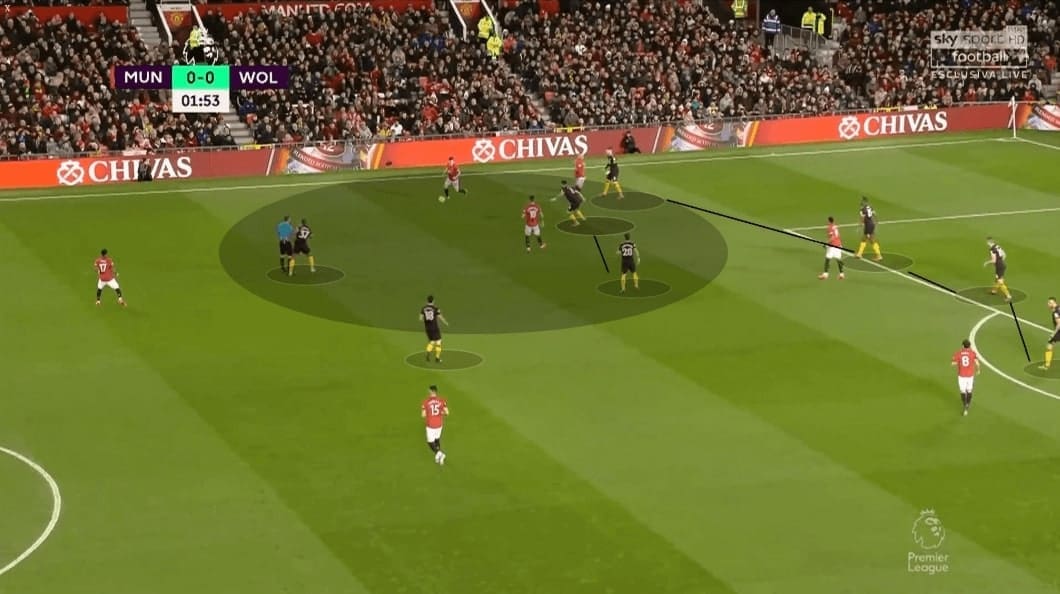
It was entertaining to watch Wolves playing as there were already a few dramatic comebacks already, such as games against City, Norwich and Southampton. Also, this team was good at scoring goals from distance – eight already this season. You could always expect Neves or Moutinho to hit a screamer.
Remaining opponents: West Ham (A), Bournemouth (H), Aston Villa (A), Arsenal (H), Sheffield (A), Everton (H), Burnley (A), Crystal Palace (H), Chelsea (A)
What to watch: how could Podence fit, the defensive block, counter-attacks
Sheffield United
Expected points: 41.6 – (8th)
Points: 43 – (7th)
Sheffield were having an amazing season under Chris Wilder. Without big names signing and attractive attacking tactics, they were having a better position than Arsenal and Tottenham, became a contender for the continental competitions next season.
When looking at the stats, Sheffield might easily be neglected except their solid defence – 25 goals conceded only this season, only Liverpool were better. Offensively, their goal-scoring ability was even worse than teams in the relegation zone (30 goals in 28 games, ranked 14th). They were also at the bottom of several metrics such as fouls suffered per 90, dribbles per 90, ranked 17th in terms of average possession and 19th in offensive duels.
Sheffield had 44.55 aerial duels per 90, ranking third in the league. Nevertheless, it does not mean Wilder were instructing the team to play directly, throwing long balls to the centre and target men. Instead, their strikers – David McGoldrick and Oliver McBurnie were working a lot across the pitch.
The below heatmaps belongs to the most used strikers of Wilder (left: McGoldrick; right: McBurnie). It was clear that both were not merely waiting for an opportunity in the penalty box. Instead, they were keen on moving at flanks as a progressive option.

Sheffield were playing a lot of crosses, 17.49 per 90 – third in the league, only behind Liverpool and City. The crosses were coming evenly from both flanks, 8.7 from the left and 8.6 from the right. Most analysis focuses on the famous overlapping centre-backs of Wilder. Instead, we are explaining how they made the crosses count here.
Apart from the centre-backs being a part of the attack, the wing-backs were keen to move into an advanced position as well. Since the wide positionings in an attack, the wing-back on the far side always stayed at the blindside of the last defender. He became a secret weapon to receive the cross in the penalty box, as no one would track his movements.
The below image is an example, Enda Stevens was totally free to exploit spaces around the penalty spot and dashed to the front post. He stayed at Doherty’s blindside until the last moment, so he was unmarked and headed the ball to Lys Mousset at the far post. Since each centre-forward were expected to occupy a defender ideally, this created two separated 1 v 1 situation, hence, not difficult for Mousset to find the back of the net in this attack.
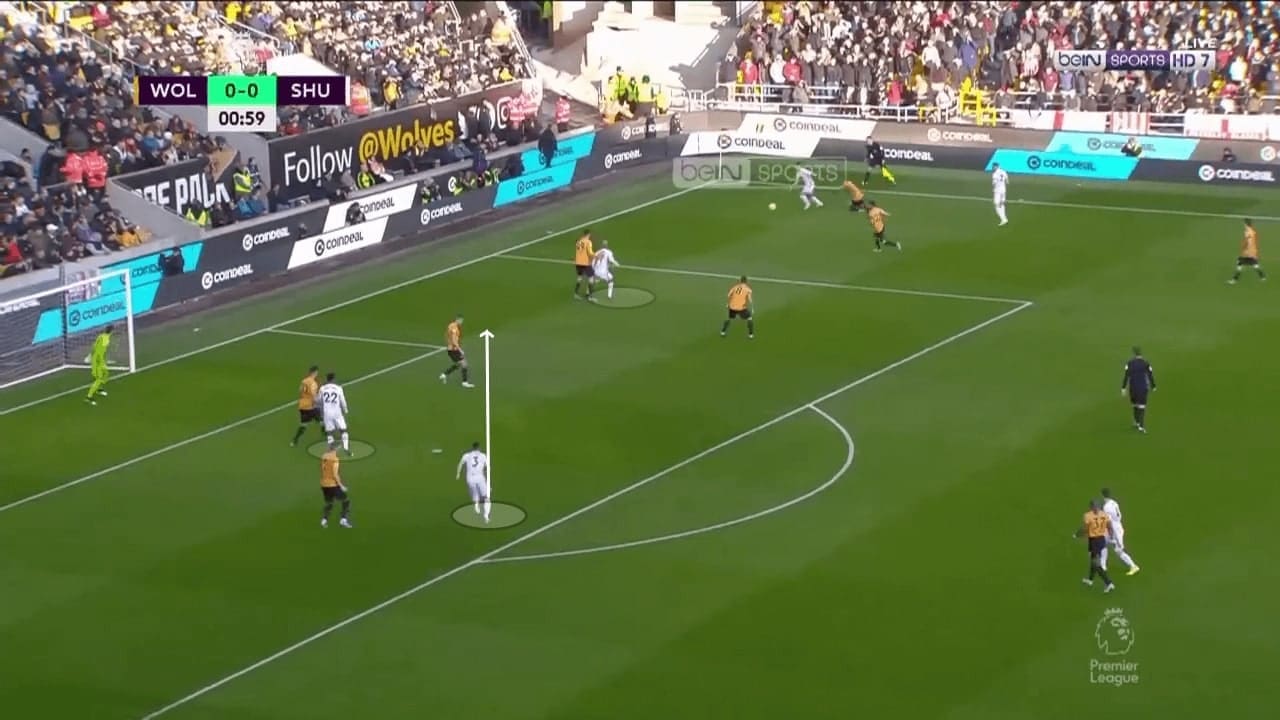
The above image has also shown a general setup of Sheffield, which would also happen in a throw-in. One striker: McGoldrick, in this case, went to the ball side, this took away a centre-back and created the horizontal gaps at defence if this was a back four. A back five like Wolves had better compactness because of an extra centre-back.
The defensive system is what made Wilder’s team tough to beat. Their average PPDA: 13.02 has reflected that the Sheffield were not a strong pressing team. They formed a very strong and disciplinary midblock to deny the opponents, playing like a 5-5 shape, similar to Wolves.
Sheffield also wished to deny central progression by keeping all of the front five at the centre – overloading this vertical zone and forced the ball wide. Wilder’s midfielders had better mobility than Wolves’ combination, as John Lundstram, John Fleck and Oliver Norwood were alert to intercept any pass within the block.
A good example would be the below image, which the horizontal gaps between Sheffield lured Nicolás Otamendi to play a risky forward pass. However, despite the relatively large distance, Sheffield were able to intercept the pass before it reached Kevin De Bruyne.
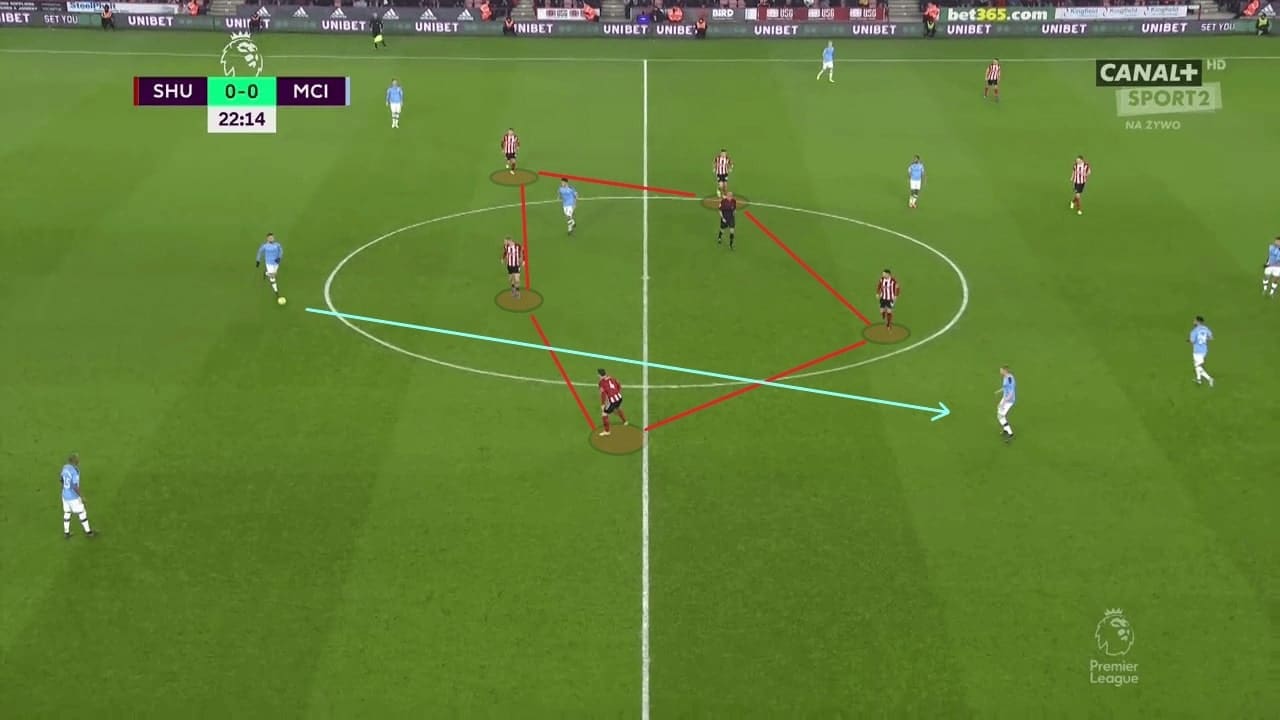
As the opposition’s attack developed, Sheffield could retreat defend with a low block. We would like to point out their main issue in this setup, which was mainly the defending of the far side wing-back. They were doing very finely to move narrow and maintain compactness with the other four. However, the body orientations were the issues.
First, the wing-backs tended to defend the zone instead of tracking the free players, which was suboptimal as the zone would not score, the players would. Second, sometimes they faced the own goal when defending, this increased the difficulty to use the preferred foot to clear the ball.
Stevens (No.3) was an example here, he defended the zone instead of tracking the run of Harry Wilson. Secondly, if using his left foot to clear the cross, the direction would be towards the byline, also potentially resulted in an own goal. The major issue in this case was his decision to defend the zone here, as he left Wilson to receive the cross to score.
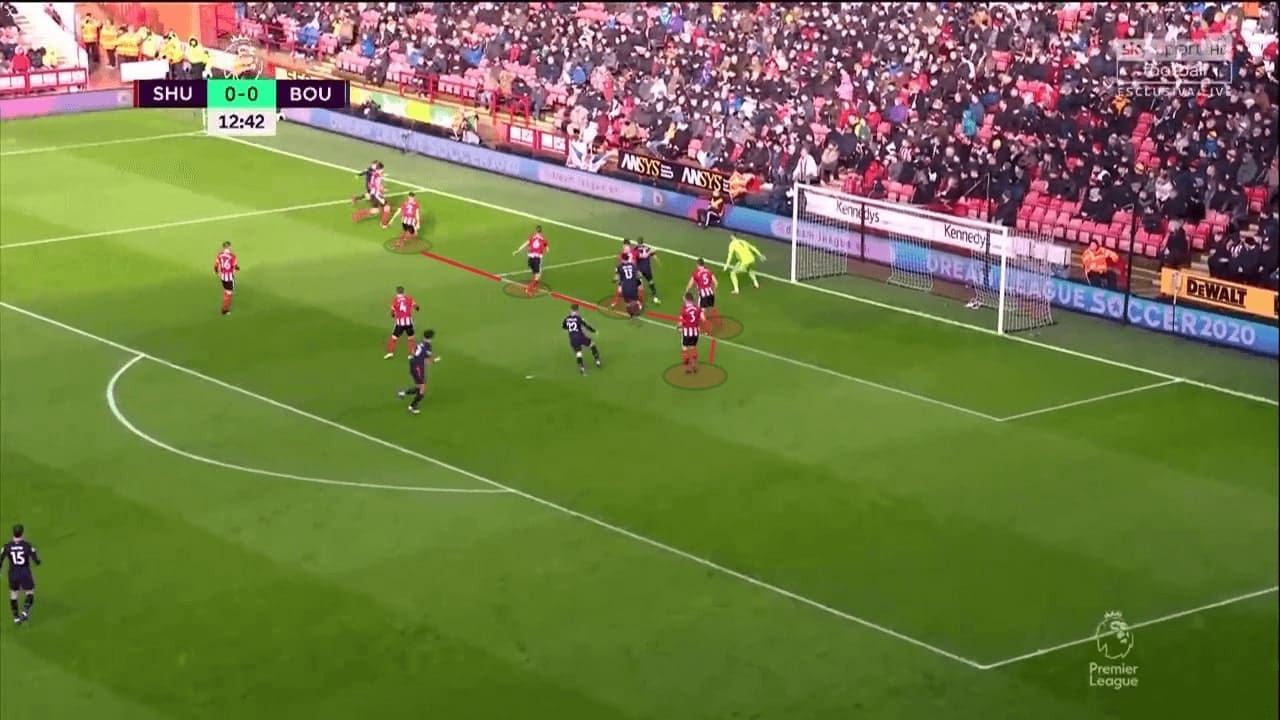
Sheffield had a quite tough schedule in the last 10 games. Most of their opponents were competing for a continental competition seat next season, it totally depends on Wilder to continue pushing the team for a better result or just stop here.
Remaining opponents: Newcastle (A), Manchester United (A), Tottenham (H), Burnley (A), Wolves (H), Chelsea (H), Leicester (A), Everton (H), Southampton (A)
What to watch: how could Berge fit, the overlapping centre-backs, disciplinary of the midblock
Southampton
Expected points: 40.6 – (9th)
Points: 34 – (14th)
Speaking of Southampton this season, maybe you would think of the 0-9 loss to Leicester and believed they were a bad team. However, Ralph Hasenhüttl managed to boost the team performance and brought them back to the mid table.
On most occasions, they lined-up in a 4-4-2 formation with Shane Long and Danny Ings partnering as the striker. Hasenhüttl’s men could flexibly attack by playing out from the back or going long.
The below image is the average formation of Southampton in the Premier League this season, you could see they adopt an asymmetrical attacking scheme, pushing the left-back higher than the right-back. It was reasonable as Ryan Bertrand was very aggressive than the personnel on the right.
Another two points should be noticed was the close proximity of the midfielders and the strikers. We will explain more below.
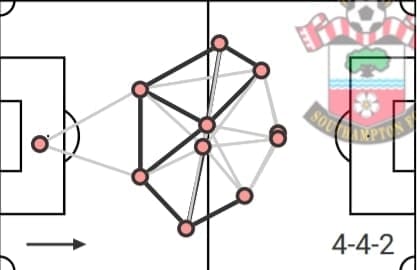
This was an in-game situation – we drew the above-mentioned features out. The midfielders could occupy the opposition midfielders in this setup, hence, bought time for the centre-backs to circulate the ball. The right-back was always a short option for the team on the right, manipulating the opposition left-winger.
Both strikers were alert to the long balls all the time, they were chasing every through pass for an opportunity. We should also note that the wingers inverted to the half-spaces to look for the second balls or the lay-offs.
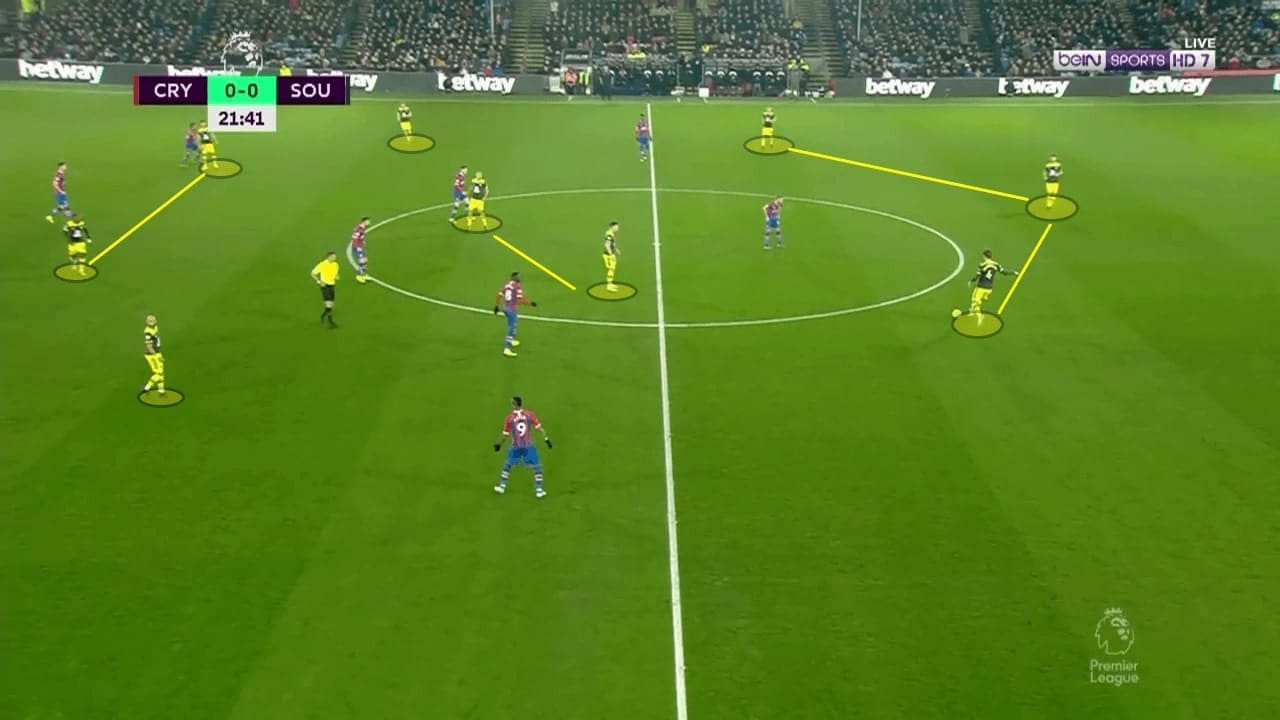
When entering the offensive third, Southampton were very good at attacking the box. With the strikers and the inverted wingers, at least they had two to three players running into the box. The runs were spread into different directions which makes the opponents very difficult to track.
An example would be this goal, you could see they had Pierre-Emile Højbjerg, Long and Michael Obafemi attacking the box. These three players were picking different routes and positions, in a 3 v 3 situation, West Ham failed to track all runs and two players (#7 Long and #20 Obafemi) were free to receive the cross here.
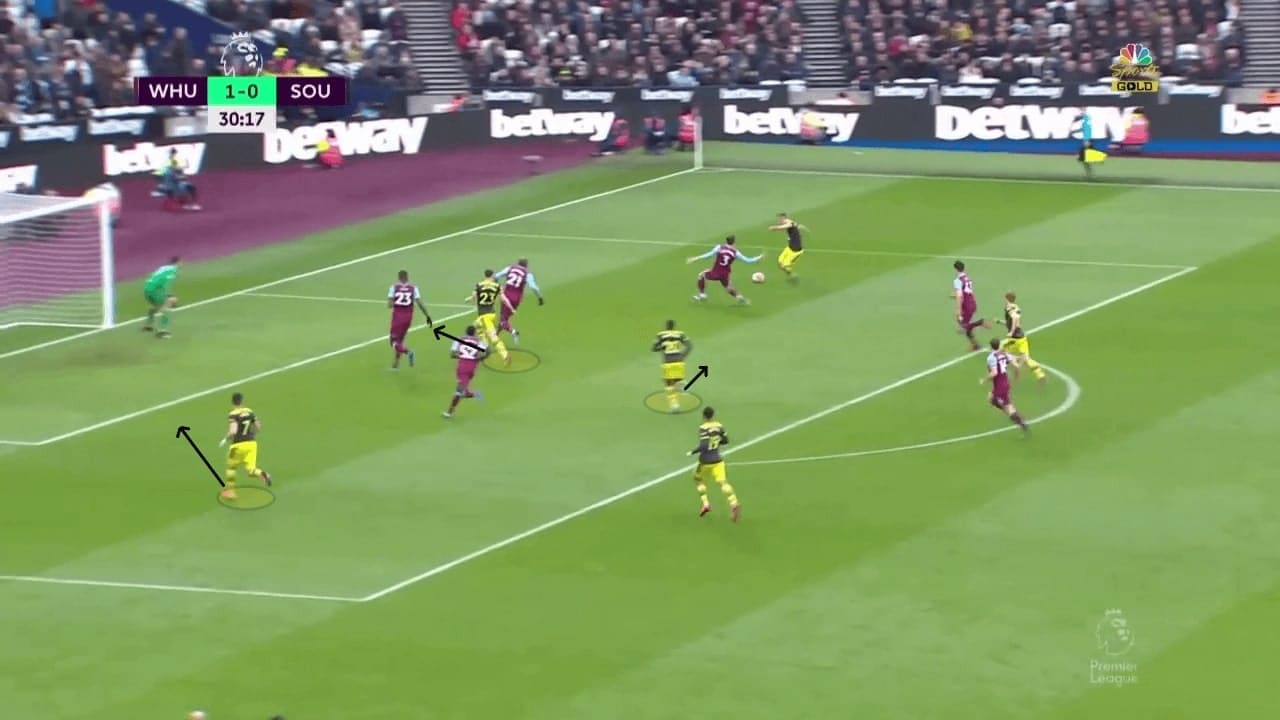
Maybe, surprisingly, Southampton had the lowest PPDA in the league – 8.07, while that of Liverpool and City were 8.50 and 8.69. In other words, they were an extremely aggressive team off-the-ball, always look to press their opponent.
The pressing scheme was a mix of ball-oriented and zone-oriented. Leading by the player nearest to the ball, they pressed with sprints and gave the oppositions no time to think. When the opponent escaped with a pass, the player nearest to the receiver followed him tightly to maintain the pressure. This intense approach helped Southampton to recover more balls than any other team per 90 – 82.48.
The below image is an example, Stuart Armstrong’s press triggered Aston Villa to pass the ball wide. You could see the receiver was already under pressure from the right-back (James Ward-Prowse). Therefore, Villa had to pass again and Douglas Luiz (#6) was the receiver, but hardly could the Brazilian midfielder play the ball out as a free man as Long was behind him. They stopped the development of the attack and forced a return pass – Villa had to reorganize.
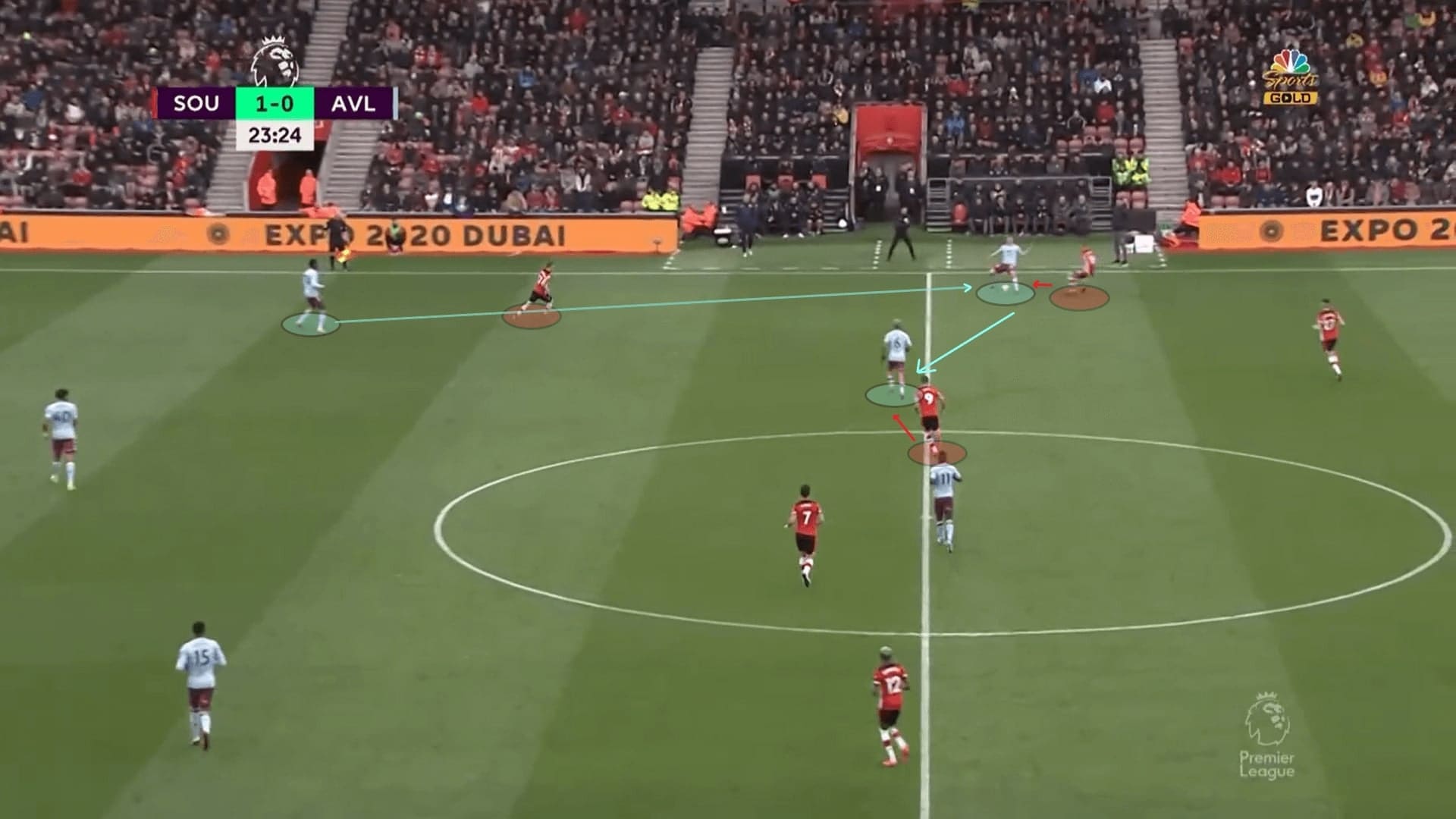
The Saints were underperforming this season, having a -14.1 xG difference and received 6.5 points less than the xPt. They were seven-point clear to the relegation zone, it should not be a difficult task to remain in the Premier League next season. They some tough opponents in the last nine games, but there were a few matches Southampton should win as highlighted.
Remaining opponents: Arsenal (H), Watford (A), Manchester City (H), Everton (A), Manchester United (A), Brighton (H), Bournemouth (A), Sheffield United (H)
What to watch: the intensive pressing scheme, Ings, Moussa Djenepo
Watford
Expected points: 37.3 – (12th)
Points: 27 – (17th)
Watford are another team that underperformed this season, as the above xPt has shown, they should be much higher than they are now. After sacking Javi Gracia and Quique Sánchez Flores, it seemed Watford had found the right man – Nigel Pearson. The former Leicester coach took them away from the bottom, and they were in the battle again.
Watford often played in a 4-2-3-1 under Pearson, the return of Troy Deeney and improvement of Ismaïla Sarr were huge boosts to the team. Meanwhile, placing Abdoulaye Doucouré as the attacking midfielder also released his offensive ability – finishing and releasing the wide players.
With Deeney, Watford were a lot better in the air because of the skipper’s physical strengths. Not only were they attacking directly in the open plays, but Deeney’s aerial ability was also utilized in the set-pieces and throw-ins.
Sarr has gone through the adaption period, his pace has made him a dangerous player in the counter-attacks. The below image was an example on how they beat Liverpool – Sarr was quick to run behind Virgil van Dijk to receive the through ball.
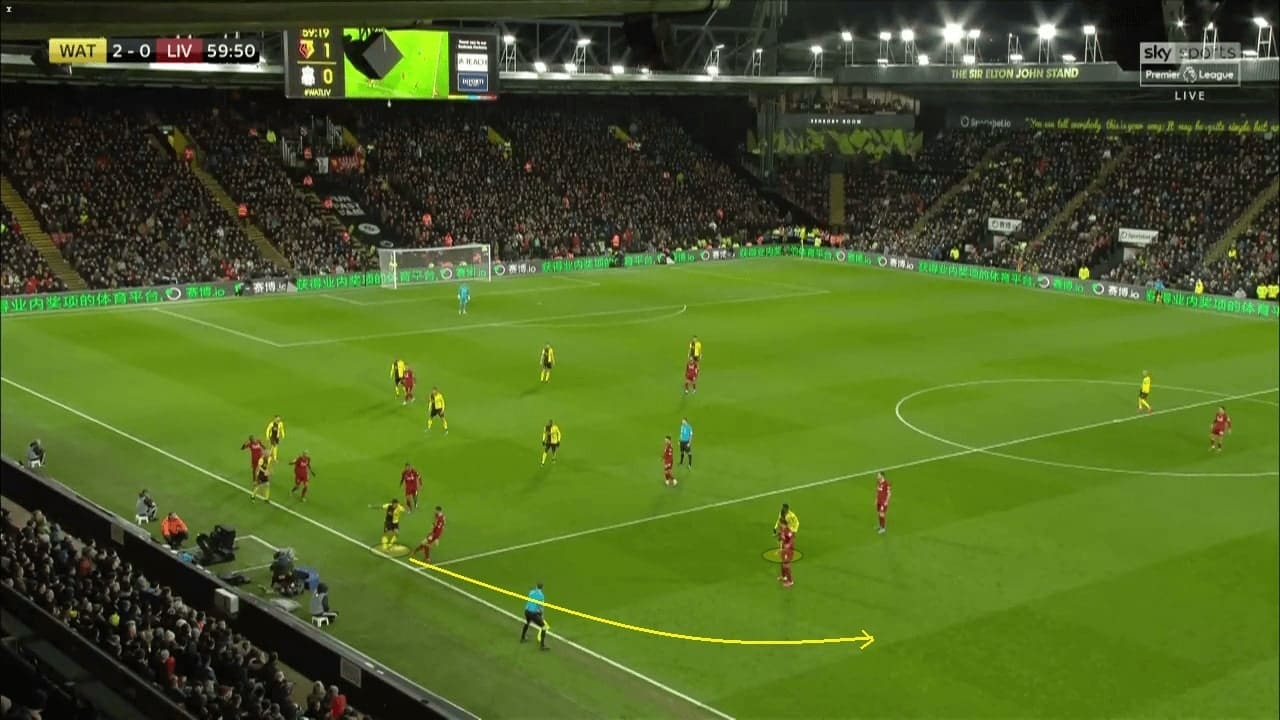
In fact, what made Watford better than the early stage of the season was their pressing. They were hardworking off-the-ball, counter-pressing once they lost the ball. The press was relying on the overloading on the ball side and high intensity, Watford pressed intensely on the ball with the support of midfielders.
The secret weapons were the positions of Doucouré and the far side winger. When pressing, Doucouré pushed higher while the far side winger stayed at the half-spaces to maintain the compactness. Therefore, once Watford regained the ball by the press, these two were the highest players to attack the opponent goal and both of them were strong to finish in these situations.
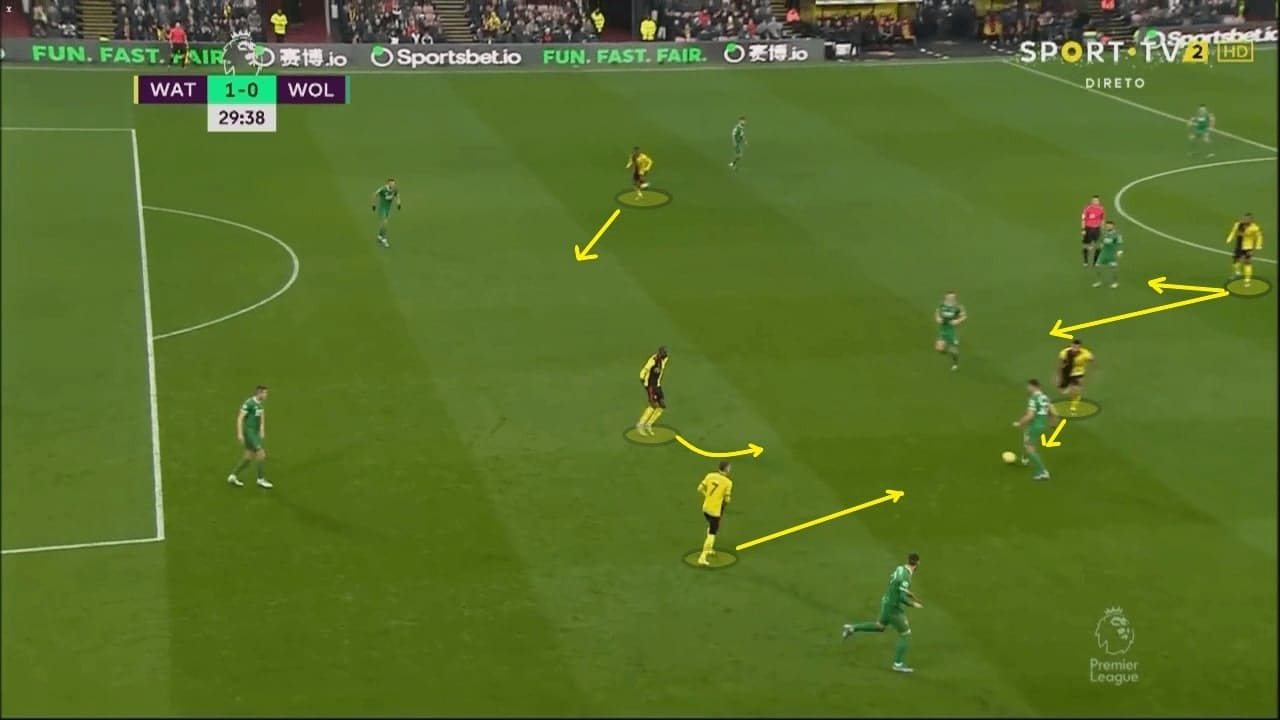
Apart from pressing high, Watford were also able to defend with a midblock or a low block. In this setup, the two defensive midfielders stayed close at the centre with the centre-backs, forming a boxed shape. This contained and eliminated the players within the box as an option to pass. When the defenders were defending deeper in the six-yard box, the pivots also retreated deeper to cover the edge of the area or the crosses.
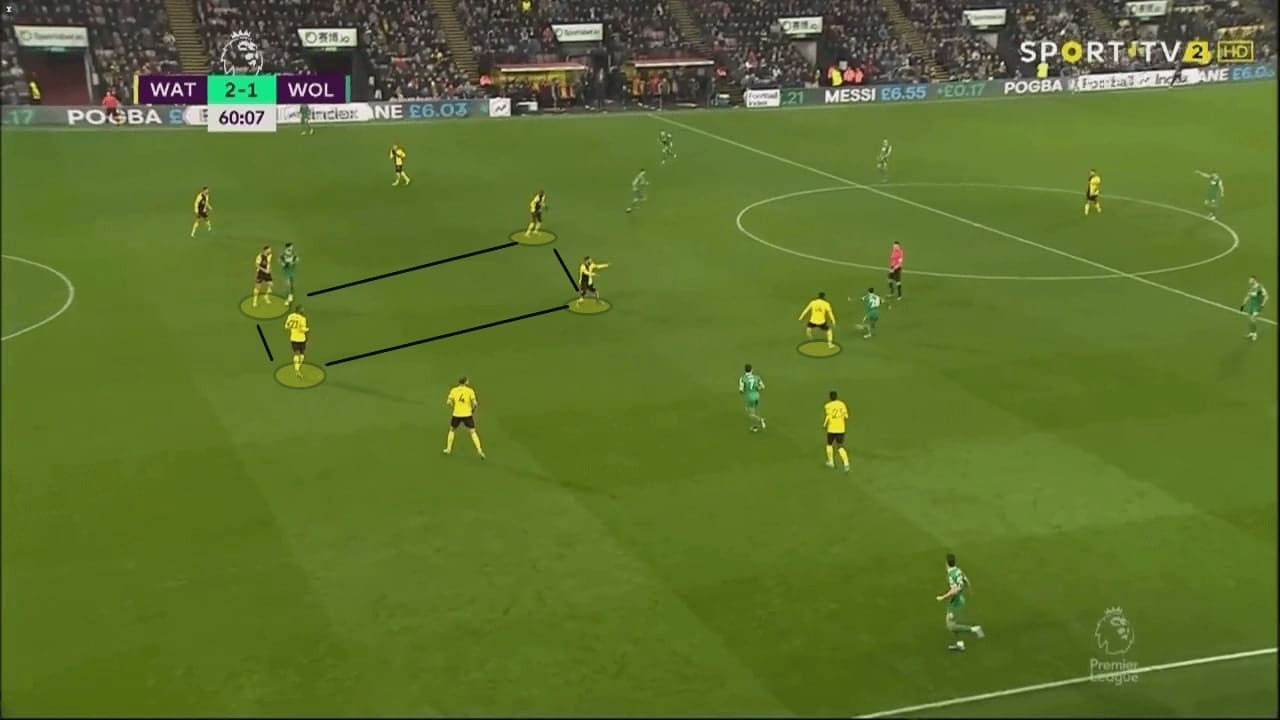
Watford were showing good signs when Pearson just came, but the results were a bit unstable before the COVID-19 break. It would be difficult to press in the same intensity in such a tight fixture, Watford would have to seize the chances to win the important battles between other teams in the relegation zone.
Remaining opponents: Leicester (H), Burnley (A), Southampton (H), Chelsea (A), Norwich (H), Newcastle (H), West Ham (A), Manchester City (H), Arsenal (A)
What to watch: Deeney, counter-pressing and pressing
Final remarks
The above was mainly explaining the general style of plays of teams. It was difficult to show all the variations and tactics of the teams in a concentrated version analysis. We wish these would give you some hints and suggestions on what to notice when the Premier League returns. We will cover the whole league, there is still one more to come!




Comments